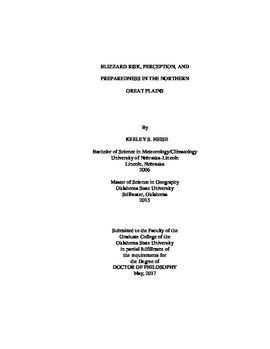| dc.contributor.advisor | Stadler, Stephen John | |
| dc.contributor.author | Heise, Keeley S. | |
| dc.date.accessioned | 2018-04-23T19:35:17Z | |
| dc.date.available | 2018-04-23T19:35:17Z | |
| dc.date.issued | 2017-05 | |
| dc.identifier.uri | https://hdl.handle.net/11244/299512 | |
| dc.description.abstract | With extreme weather events expected to increase as the planet warms, weather disasters and society's vulnerability to them are becoming more frequently studied. One of the weather hazards of most concern in the north-central United States is the blizzard. Blizzards are among the deadliest and costliest events in the United States, and the Northern Great Plains experience these events more frequently than anywhere else in the US. The purpose of the research presented in this dissertation is to apply existing knowledge to a hazard that is underrepresented in the literature. Previous studies on blizzards have mainly focused on climatological data, and the few that did include information on perception and preparedness did so using only quantitative survey questions, which do not allow the survey respondent to expand on their view points. For vulnerability analyses, much of the research is done at the county level though the research consistently argues that vulnerability is a more localized phenomenon. It may be better understood and provide more efficient resource allocation if studies are done at smaller geographic levels, such as the Census tract. Data for the snow seasons of 1950/51 through 2010/11 were used to determine the areas in the Northern Plains had highest exposure as well as which time of year is the most likely to experience blizzards. According to the seasonal exposure analysis, South Dakota experienced the most blizzards. The months of March and April combined (termed late-season) exhibited the highest exposure with the month of March showing the highest overall. Throughout the study period, a significant decreasing trend in the number of storms was observed. Multiple indices were calculated and compared at the tract level for one county within the study area, and surveys were also distributed to ascertain perception and preparedness in the two most active states using both open-ended and closed-ended questions. Through the use of surveys, it was found that the residents of North and South Dakota know what a blizzard entails and are highly prepared for such a storm. Little demographic difference was found in the open-ended questions, and this may be due to their experience with blizzards. Tract level analysis was done using a method previously published and created for county-level analysis by Miller, Johnson, and Dobson. Using variables from the 2010 U.S. Census and the 2008-2012 5-year American Community Survey, social vulnerability and resilience indices were calculated for the tracts of Cass County, North Dakota and then combined into quadrants. Three difference indices were calculated by switching the index in which the heating variables were included. Only three Census tracts changed: one in Fargo, and two larger rural tracts in the northern and western parts of the county. This suggests that the use of gas versus electric heat does not have much of an impact on blizzard vulnerability or resilience, except for those residents that live in more remote locations. | |
| dc.format | application/pdf | |
| dc.language | en_US | |
| dc.rights | Copyright is held by the author who has granted the Oklahoma State University Library the non-exclusive right to share this material in its institutional repository. Contact Digital Library Services at lib-dls@okstate.edu or 405-744-9161 for the permission policy on the use, reproduction or distribution of this material. | |
| dc.title | Blizzard risk, perception, and preparedness in the Northern Great Plains | |
| dc.contributor.committeeMember | Wikle, Tom | |
| dc.contributor.committeeMember | Bays, Brad Alan | |
| dc.contributor.committeeMember | Gill, Duane A. | |
| osu.filename | Heise_okstate_0664D_15271.pdf | |
| osu.accesstype | Open Access | |
| dc.type.genre | Dissertation | |
| dc.type.material | Text | |
| thesis.degree.discipline | Geography | |
| thesis.degree.grantor | Oklahoma State University | |
